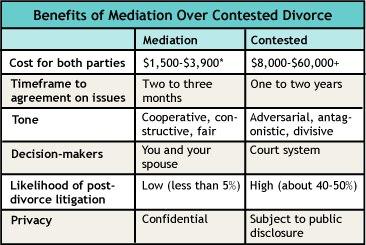How Does The Mediation Process Work?
Mediation is a dynamic, structured, interactive process where a trained and impartial third party known as the mediator, assists and guides the disputing parties in resolving business, family or community conflicts through the use of specialized techniques of communication and negotiations. All participants in mediations must first agree to actively participate in the process and the final agreement is ultimately the decision of the parties involved. Mediation is an opportunity to come to an agreement in resolving their differences without the high cost of attorneys and court fees. All parties agree to disclose the facts, specially in divorce or business cases involving dissolution of assets and investments. Once an agreement is reached, the mediator can then draft the agreement and all parties can sign and notarize the document. A family mediator will also address issues of custody and visitations, phone communications, schedules, child support, asset dissolution and any investments.
The 6 steps of a mediation process:
1. Introductory Remarks:
The outline of the role of the participants and the mediator's neutrality and what they see as the issues if briefs were pre-submited, as well as the guidelines and rules of mediation, the process involved and the agreement of the parties to participate in a respectful and honest manner.
2. Statement of the Problem by the Parties
Each party will speak uninterrupted in order to shed light on their emotional state, as well as to frame the issues in their own mind.
3. Information gathering
The mediator asks open ended questions in order to get to the emotional undercurrents, summarizing the facts to confirm and also to build rapport.
4. Identification of the problems
The mediator tries to find common goals between parties to find out which issues are going to be able to settle and in what order.
5. Bargaining
The mediator may suggest hypothetical scenarios or a proposal for the parties to possibly modify until they can reach an agreement with the goal to help them reach some common ground by exploring options that may bring a possible solution. The mediator may also talk to each party separately to create a safe environment to find out their underlying fears.
6. Final settlement
Once the parties reach an agreement, a Memorandum of Understanding is drafted to be signed and notarized. The terms of the agreement are clarified and a resolution is reached, allowing the parties in conflict to move forward with their lives and put this all behind them.
Post Mediation Family Services:
1. Assistance with scheduling, visitation, agreement changes and payments with a monitored and permanently documented system.
2. Neutral phone, text or email communications with parties to avoid unnecessary, harassing contacts that create further conflict.
3. Permanent storage of uploaded documents, communications and journals of events for possible future legal use.
4. Low cost, customized packages based on your personal needs and frequency of changes or contacts.



